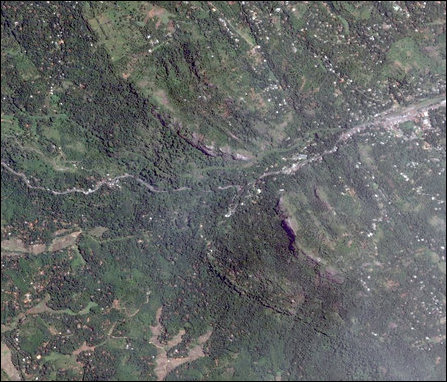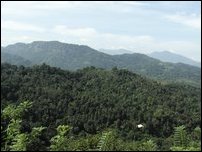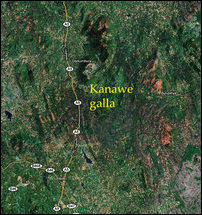Know the Etymology: 169
Place Name of the Day: Tuesday, 23 November 2010
Kadugannawa
கடுகன்னாவ (கடு-கணவாய்)
kaḍugannāvaKadu+gannaawa
Kadu+ganaawa
Kada+gannaawa
Kada+ganaawa
The fierce mountain pass
The mountain pass at the frontier
The mountain pass to traverse
| Ganaawa | Canal (Sinhala place names); Kanavaya: Also Kanavaya: A canal (Paranavitana. S., Later Brahmi Inscriptions of Ceylon, nos. 14, 46 and 61); Kanavaay: Mountain pass, ravine (Tamil, Dravidian Etymological Dictionary 1163); Kanavaa: Mountain ghat, ravine (Malayalam, DED 1163); Kaname, Kanave, Kanime, Kanive: Narrow pass between two mountains (Kannada, DED 1163); Kan-vaay: Sluice; Kan-paay: Canal; Kan-maay, Kammaay: Irrigation tank (Tamil, Tamil Nadu); Kaan: Canal, gutter (Eezham Tamil) |
| Katu |
(adjective) Fierce, displeasing, thorny, hot, pungent (Sinhala); Kadu: (adjective, verb, Urichchol) Harsh, severe, fierce, sharp, pricking, painful, hot, pungent etc (Tamil, Changkam and modern diction, Dravidian Etymological Dictionary 1135); Extreme, fierce, excessive etc (Malayalam, DED 1135); Severe, sharp, excessive (some other Dravidian languages, DED 1135); Kadu-varai: Steep mountain; Kadu-vazhi: Difficult passage (Tamil usages); Katu: Pungent, sharp, fierce, hot (Sanskrit); Katukka: Sharp, severe, painful, pungent (Pali / Prakrit) |
| Kada-ima |
Limit, boundary of a country, frontier (Sinhala); Kadai: End, limit, boundary (Tamil, Dravidian Etymological Dictionary 1109), from the verb root Kada: (verb) To pass through, traverse, cross (Tamil, Dravidian Etymological Dictionary 1109); Kadavu, Kadavai: Way, path (Tamil, DED 1109) |
| Kada |
(adjective of Kadam): The side of a hill, hard and difficult path in a barren track (Tamil, also Tamil place names, Pinkalam Lexicon, DED 1438); Kada: The difficult side of a hill (Sinhala, as in Kandyan usage Sen-kada-gala, the old name for Kandy); Gada: Stone, impediment, obstacle, fence, ditch, moat (Sinhala). See column on Kandy. |

Kadugannawa: The mountain pass that rises from 600 feet at the bottom to 3000 feet at the top showing highway and railway lines. This is the key mountain pass to get into the hill country of the island from the western side. [Image courtesy: Google Earth]

Details of the mountain pass at Kadugannawa. [Image courtesy: Google Earth]
The fierce and formidable mountain pass at Kadugannawa is well known in the history of the island, especially related to the colonial wars against the kingdom of Kandy.
The steep mountain pass at this place rises from a few hundred feet to roughly 3000 feet. This key mountain pass was traditionally the frontier to get into the kingdom of Kandy and to the hill-country from the western side of the island.

A railway line through Kadugannawa mountain pass became operative in the late 19th century. [Image courtesy: Lankapura.com]

Two views of the mountains from Kadugannawa [Image courtesy: Google Earth]

Yuda-ganaawa: The linking canal (shown parallel to the river) at Yuda-ganaawa. [Image courtesy: Metric Sheet, Survey Department]

Yuda-ganaawa: the linking canal seen parallel to the river at its right. [Image courtesy: Google Earth]

Kanawe-galla: The rocky hills having a pass. Note the watershed of the two rivers Maduru Oya and Maha Oya in opposite directions. The mid point of the pass is also a point where the boundaries of Badulla, Moneragala and Ampaarai districts meet. [Image courtesy: Metric sheet, Survey Department]

Kanawe-galla: Note the rock-hill ranges and the pass. [Image courtesy: Google Earth]
Kadugannawa mountain pass is of foremost importance in the transportation network of the island as the Colombo Kandy A1 Highway and the railway line to the entire hill-country have to pass through it.
Old British maps spell the place name in English as Kaduganawa. Both Kadugannawa and Kaduganawa are pronounced as Kadugannaawa and Kaduganaawa.
The suffix of the place name Gannaawa or Ganaawa seems to be a cognate of the Tamil / Dravidian Kanavaay which means a mountain pass.
The word may not be found in the contemporary Sinhala diction, but the words Kanavaya and Kanavaya are found used in the Brahmi inscriptions of the island to mean a canal, especially an irrigation canal of a reservoir (Paranavitana, S., Inscriptions of Ceylon, Volume II, Later Brahmi Inscriptions, entry numbers 14, 46 and 61).
Interestingly, a term Ganaawa appears in some Sinhala place names in the context of canals. An illustrative example is
Yuda-ganaawa in Buttala division of Moneragala district. There is a canal joining two points of the river Menik-ganga. The village is also called Yuda-gannawa-gama, meaning the village of the joining canal. Yuda is from the word Yuja in Sinhala meaning, to join, to combine etc (Ja and Da interchange in Sinhala). Yodanawaa in Sinhala also means 'to unite'.
Handa-ganaawa in Minipe division, Kandy district is a place where two canals coming from Minipe-yoda-Ela meet. (Handa is adjective of Handiya in Sinhala, meaning junction or joint)
Another example in which the word begins with K itself is
Kanawe-galla in the Bibile division of Moneragala district. Kanawe-galla is a mountain pass. The place marks a pass in a rocky hill range northeast of Bibile, which is also the watershed for the rivers Maduru Oya and Maha oya.
Kanavaay in Tamil and its cognates Kanavaa in Malayalam and Kanave etc in Kannada generally mean a mountain pass. But the word, etymologically originating from Kan (eye, aperture, DED1159) and Vaay (mouth, DED 5352) > Kanavaay, meaning a narrow opening or narrow passage, was also used in many other contexts.
Kan-vaay, meaning sluice and Kan-paay meaning an irrigation canal coming from a reservoir, later caused the word formation Kammaay for an irrigation tank in the Tamil usage of Tamil Nadu.
In contemporary Eezham Tamil, Kaan, a shortened form Kanavaay, means a canal or gutter.
* * *The prefix Kadu of the place name Kadu-gannaawa, could be interpreted in different possible ways with the help of Sinhala and Tamil diction.
If the prefix is taken as Katu becoming Kadu (as the following word begins with G), then it may mean fierce in Sinhala. Kadu as an Urichchol in Tamil (word inherent to the language to mean abstract qualities) means the same as in Sinhala (see table for comparison). The word, found in the usage of many other Dravidian languages too, is listed as Dravidian in DED entry 1195, even though it is also found in Sanskrit / Prakrit.
If the prefix is taken as Kada becoming Kadu (so that K became G in the following word), then the prefix may mean either a frontier or a passage.
Kada-ima in Sinhala is a frontier or boundary. One shade of the meaning for Kadai in Tamil (DED 1109) is also the same. It comes from the verb root Kada in Tamil that means to pass, cross, pass through, traverse etc. Kadavu and Kadavai in Tamil are some derivates that mean a way, path or a passage to pass through. All of them are of Dravidian etymology (DED 1109).
In yet another possibility, Kada as an adjective of Kadam (Tamil, DED 1438) may mean a difficult path or the difficult side of a hill. In this sense the word is also found used in Kandyan Sinhalese as could be seen in the place name Sen-kada-gala, the old name for Kandy. See column on
Kandy.
Kadugannawa is located in the Yatinuwara division of Kandy district.
* * *Some related place names: Ganaawa/ KanavaayYudha-ganaawa: The joining canal, Buttala division, Moneragala district. There is a canal at this place that starts from one point of the river Menik Ganga, runs parallel to the river and joins with it at another point. There is another Yuda-ganaava at Medirigriya division, Polonnaruwa district. Yuja: to unite, to combine (Sinhala, Ja and Da interchange). Yodanawaa: to unite (Sinhala).
Handa-ganaawa: The joining canal or the canal juction, Minipe division, Kandy district. Two canals coming from Minipe-Yoda-Ela meets at this place. Handiya: Joint, junction (Sinhala, cognate of Sandhi in Sanskrit)
Kanaawa: The canal, Ganewatta division, Kurunegala district. A canal passes through this village
Kanawe-galla: The rock-hill range having a pass, Bibile division, Moneragala district. This place northeast of Bibile has a mountain pass, which is also a watershed for the two rivers Maduru Oya and Gal Oya that run in opposite directions.
Kadu: Kadu-wela: The steep bank or the bank to cross, Kadu-wela division, Colombo district. This was an important point in the past to cross the river Kelani Ganga. There is a bridge here now linking highways.
Kadu-goda: The steep hill, Hanwella division, Colombo district. The hills of the highland begin at Kadugoda. There are steep hills at this place immediately rising to 600 feet from the plains.
First published: Tuesday, 23 November 2010, 06:55
Previous columns:















